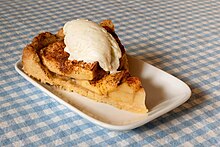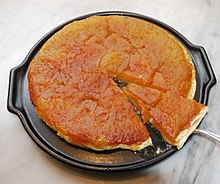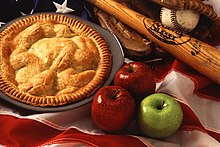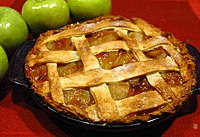|
Apple pie
An apple pie is a pie in which the principal filling is apples. Apple pie is often served with whipped cream, ice cream ("apple pie à la mode"), custard or cheddar cheese.[3] It is generally double-crusted, with pastry both above and below the filling; the upper crust may be solid or latticed (woven of crosswise strips). The bottom crust may be baked separately ("blind") to prevent it from getting soggy. Tarte Tatin is baked with the crust on top, but served with it on the bottom. Originating in the 14th century in England, apple pie recipes are now a standard part of cuisines in many countries where apples grow. Apple pies are an unofficial symbol of the United States and one of its signature comfort foods.[4] Ingredients Apple pie can be made with many different sorts of apples. The more popular cooking apples include Braeburn, Gala, Cortland, Bramley, Empire, Northern Spy, Granny Smith, and McIntosh.[5] The fruit for the pie can be fresh, canned, or reconstituted from dried apples. Dried or preserved apples were originally substituted only at times when fresh fruit was unavailable. The basic ingredients of the filling are sugar, butter, a thickener like cornstarch and an acidic ingredient like lemon juice. Spices are added most commonly cinnamon, nutmeg.[2] and lemon juice which is used to prevent oxidation of the apples when macerating the filling. Many older recipes call for honey in place of the then-expensive sugar.[6] Serving Apple pie is often served à la mode, that is, topped with ice cream. In another serving style, a piece of sharp cheddar cheese is placed on top of or alongside a slice of the finished pie.[7][8][9] Apple pie with cheddar is popular in the American Midwest and New England, particularly in Vermont, where it is considered the state dish.[3] In the north of England, Cheddar or Wensleydale cheese is often used.[10][11] Nutrition
A commercially prepared apple pie is 52% water, 34% carbohydrates, 2% protein, and 11% fat (table). A 100-gram serving supplies 237 Calories and 13% of the US recommended Daily Value of sodium, with no other micronutrients in significant content (table). English style The 14th century recipe collection the Forme of Cury gives a recipe including good apples, good spices, figs, raisins and pears in a cofyn, a casing of pastry. Saffron colours the filling.[14] Lattice pastry styles were found from the 17th century alongside the more traditional dome shaped pie crust.[15] Modern English versions incorporate thick layers of sweetened slices of, usually, Bramley apple; layered into a dome shape to allow for downward shrinkage, and thus avoid a saggy middle; then topped with butter or lard shortcrust pastry; and baked until the apple filling is cooked.[citation needed] In English-speaking countries, apple pie, often considered a comfort food, is a popular dessert, eaten hot or cold, on its own or with ice cream, double cream, or custard. Apple pies are often sold as mini versions in multipacks.[citation needed] Dutch style  Recipes for Dutch apple pie go back to the Middle Ages. An early Dutch language cookbook from 1514, Een notabel boecxken van cokeryen ("A notable little cookery book"), letterpress printed in Brussels by Thomas van der Noot, who may also have been the author,[16] documents a recipe for Appeltaerten (modern Dutch Appeltaarten 'apple pies'). This early recipe was simple, requiring only a standard pie crust, slices of especially soft apples with their skin and seeds removed, and den selven deeghe daer die taerte af ghemaect es (more of the same dough) on top. It was then baked in a typical Dutch oven. Once baked, the top crust (except at the edges) would be cut out from the middle, after which the apple slices were potentially put through a sieve before the pie was stirred with a wooden spoon. At this point the book recommends adding several spices to the pie, namely: cardamom, ginger, cinnamon, nutmeg, clove, mace and powdered sugar. Finally, after mixing the ingredients into the pie with cream, it is once again put into the oven to dry.[17] Traditional Dutch apple pie comes in two varieties, a crumb (appelkruimeltaart) and a lattice (appeltaart) style pie. Both recipes are distinct in that they typically call for flavourings of cinnamon and lemon juice to be added and differ in texture, not taste.[18][19] Dutch apple pies may include ingredients such as full-cream butter, raisins and almond paste, in addition to ingredients such as apples and sugar, which they have in common with other recipes.[20] The basis of Dutch apple pie is a crust on the bottom and around the edges. This crust is then filled with pieces or slices of apple, usually a crisp and mildly tart variety such as Goudreinet or Elstar. Cinnamon and sugar are generally mixed in with the apple filling. Atop the filling, strands of dough cover the pie in a lattice holding the filling in place but keeping it visible or cover the pie with crumbs. It can be eaten warm or cold, sometimes with a dash of whipped cream or vanilla ice cream. In the US, "Dutch apple pie" refers specifically to the apple pie style with a crumb, streusel, topping.[21][22] French style One kind of French style apple pie is very different compared to the typical version of the sweet dessert. Instead of it being right side up with crust on top and bottom, it actually is upside down, with the fruit being caramelised. This can be made not only with apples but other fruits or vegetables as well, for example, pears or tomatoes. See Tarte Tatin. Others use a more traditional presentation, including variants like the Norman tart. Swedish styleThe Swedish style apple pie is predominantly a variety of apple crumble, rather than a traditional pastry pie. Often, breadcrumbs are used (wholly or partially) instead of flour, and sometimes rolled oats. It is usually flavoured with cinnamon and served with vanilla custard or ice cream. There is also a very popular version called äppelkaka (apple cake), which differs from the pie in that it is a sponge cake baked with fresh apple pieces in it. In American culture Apple pie was brought to the colonies by the English, the Dutch, and the Swedes during the 17th and 18th centuries.[citation needed] Two recipes for apple pie appear in America's first cookbook, American Cookery by Amelia Simmons, which was published in 1796.What America's First Cookbook Says About Our Country and Its Cuisine The apple pie had to wait for the planting of European varieties, brought across the Atlantic, to become fruit-bearing apple trees, to be selected for their cooking qualities as there were no native apples except crabapples, which yield very small and sour fruit.[23] In the meantime, the colonists were more likely to make their pies, or "pasties", from meat, calling them coffins (meaning basket)[24] rather than fruit; and the main use for apples, once they were available, was in cider. However, there are American apple pie recipes, both manuscript and printed, from the 18th century, and it has since become a very popular dessert.[4] Apple varieties are usually propagated by grafting, as clones, but in the New World, planting from seeds was more popular, which quickly led to the development of hundreds of new native varieties.[25] Apple pie was a common food in 18th-century Delaware. As noted by the New Sweden historian Dr. Israel Acrelius in a letter: "Apple pie is used throughout the whole year, and when fresh Apples are no longer to be had, dried ones are used. It is the evening meal of children."[26] The mock apple pie, made from crackers, was probably invented for use aboard ships, as it was known to the British Royal Navy as early as 1812.[27] The earliest known published recipes for mock apple pie date from the antebellum period of the 1850s.[28][29] In the 1930s, and for many years afterwards, Ritz Crackers promoted a recipe for mock apple pie using its product, along with sugar and various spices.[30] Apple pie was one of the dishes that Rhode Island army officers ate for their Fourth of July celebrations during the Siege of Petersburg.[31] Although eaten in Europe since long before the European colonization of the Americas, apple pie as used in the phrase "as American as apple pie" describes something as being "typically American".[32][33] In the nineteenth and twentieth centuries, apple pie became a symbol of American prosperity and national pride. A newspaper article published in 1902 declared that "No pie-eating people can be permanently vanquished."[34] The dish was also commemorated in the phrase "for Mom and apple pie"—supposedly the stock answer of American soldiers in World War II, whenever journalists asked why they were going to war. Jack Holden and Frances Kay sang in their patriotic 1950 song "The Fiery Bear", creating contrast between this symbol of U.S. culture and the Russian bear of the Soviet Union:
Advertisers exploited the patriotic connection in the 1970s with the commercial jingle "baseball, hot dogs, apple pie and Chevrolet". One out of five Americans surveyed (19%) prefer apple pie over all others, followed by pumpkin (13%) and pecan (12%).[35] The unincorporated community of Pie Town, New Mexico, is named after apple pie.[36] See also
References
External linksWikimedia Commons has media related to apple pies.
|
||||||||||||||||||||||||||||||||||||||||||||||||||||||||||||||||||||||||||||||||||||||||||||


